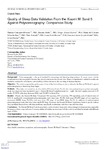Mostrar o rexistro simple do ítem
Quality of sleep data validation from the Xiaomi Mi Band 5 against polysomnography: comparison study
| dc.contributor.author | Concheiro-Moscoso, Patricia | |
| dc.contributor.author | Groba, Betania | |
| dc.contributor.author | Álvarez-Estévez, Diego | |
| dc.contributor.author | Miranda-Duro, María del Carmen | |
| dc.contributor.author | Pousada, Thais | |
| dc.contributor.author | Nieto-Riveiro, Laura | |
| dc.contributor.author | Mejuto Muiño, Francisco Javier | |
| dc.contributor.author | Pereira-Loureiro, Javier | |
| dc.date.accessioned | 2023-10-05T06:58:44Z | |
| dc.date.available | 2023-10-05T06:58:44Z | |
| dc.date.issued | 2023-05 | |
| dc.identifier.citation | Concheiro-Moscoso P, Groba B, Alvarez-Estevez D, Miranda-Duro MDC, Pousada T, Nieto-Riveiro L, Mejuto-Muiño FJ, Pereira J. Quality of sleep data validation from the Xiaomi Mi Band 5 against polysomnography: comparison study. J Med Internet Res. 2023 May 19;25:e42073. | es_ES |
| dc.identifier.issn | 1438-8871 | |
| dc.identifier.uri | http://hdl.handle.net/2183/33527 | |
| dc.description | Clinical trial (NCT04568408) | es_ES |
| dc.description.abstract | [Abstract] Background: Polysomnography is the gold standard for measuring and detecting sleep patterns. In recent years, activity wristbands have become popular because they record continuous data in real time. Hence, comprehensive validation studies are needed to analyze the performance and reliability of these devices in the recording of sleep parameters. Objective: This study compared the performance of one of the best-selling activity wristbands, the Xiaomi Mi Band 5, against polysomnography in measuring sleep stages. Methods: This study was carried out at a hospital in A Coruña, Spain. People who were participating in a polysomnography study at a sleep unit were recruited to wear a Xiaomi Mi Band 5 simultaneously for 1 night. The total sample consisted of 45 adults, 25 (56%) with sleep disorders (SDis) and 20 (44%) without SDis. Results: Overall, the Xiaomi Mi Band 5 displayed 78% accuracy, 89% sensitivity, 35% specificity, and a Cohen κ value of 0.22. It significantly overestimated polysomnography total sleep time (P=.09), light sleep (N1+N2 stages of non-rapid eye movement [REM] sleep; P=.005), and deep sleep (N3 stage of non-REM sleep; P=.01). In addition, it underestimated polysomnography wake after sleep onset and REM sleep. Moreover, the Xiaomi Mi Band 5 performed better in people without sleep problems than in those with sleep problems, specifically in detecting total sleep time and deep sleep. Conclusions: The Xiaomi Mi Band 5 can be potentially used to monitor sleep and to detect changes in sleep patterns, especially for people without sleep problems. However, additional studies are necessary with this activity wristband in people with different types of SDis. | es_ES |
| dc.description.sponsorship | This work is supported in part by some grants from the European Social Fund 2014-2020: Centre for Information and Communications Technology Research (CITIC; Research Center of the Galician University System). Grant support for CITIC was provided by the Xunta de Galicia through a collaboration agreement between the Regional Ministry of Culture, Education, and Vocational Training and the Galician Universities for the work of the Research Centers of the Galician University System and the Handytronic chair. PCM obtained a scholarship to develop the PhD thesis (ED481A-2019/069). DAE received funding from the project ED431H 2020/10 of the Xunta de Galicia. In addition, this work is supported in part by structural support for the consolidation and structuring of competitive research units and other promotion actions in the universities of the Galician University System, in the public research organizations of Galicia, and other entities of the Galician R&D&I System for 2022 (ED431B-2022/39); “Quality of life for caregivers through a person-centered technological solution” (TED2021-130127A-I00) associated with the “projects oriented to the ecological transition and digital transition” in the framework of the state program to promote scientific-technical research and its transfer, according to the state plan for scientific, technical, and innovation research 2021-2023; and the Ministerio de Ciencia e Innovación R&D&I projects in the framework of the national programs of knowledge generation and scientific and technological strengthening of the R&D&I system and challenges of the call R&D&I 2019 oriented to society (PID2019-104323RB-C33). | |
| dc.description.sponsorship | Xunta de Galicia; ED481A-2019/069 | |
| dc.description.sponsorship | Xunta de Galicia; ED431H 2020/10 | |
| dc.description.sponsorship | Xunta de Galicia; ED431B-2022/39 | |
| dc.description.sponsorship | Xunta d Galicia; TED2021-130127A-I00 | |
| dc.description.sponsorship | info:eu-repo/grantAgreement/AEI/Programa Estatal de Generación de Conocimiento y Fortalecimiento Científico y Tecnológico del Sistema de I+D+i/PID2019-104323RB-C33/ES/EVALUACION Y ASESORAMIENTO PARA LA MEJOR EFICIENCIA Y EFECTIVIDAD DE LA TECNOLOGIA DE APOYO | |
| dc.language.iso | eng | es_ES |
| dc.publisher | JMIR Publications | es_ES |
| dc.relation.uri | https://doi.org/10.2196/42073 | es_ES |
| dc.rights | Creative Commons Attribution 4.0 International License (CC-BY 4.0) | es_ES |
| dc.rights.uri | http://creativecommons.org/licenses/by/4.0/ | * |
| dc.subject | Internet of Things | es_ES |
| dc.subject | Xiaomi Mi Band 5 | es_ES |
| dc.subject | Health promotion | es_ES |
| dc.subject | Occupation | es_ES |
| dc.subject | Polysomnography | es_ES |
| dc.subject | Sleep | es_ES |
| dc.title | Quality of sleep data validation from the Xiaomi Mi Band 5 against polysomnography: comparison study | es_ES |
| dc.type | info:eu-repo/semantics/article | es_ES |
| dc.rights.access | info:eu-repo/semantics/openAccess | es_ES |
| UDC.journalTitle | Journal of Medical Internet Research | es_ES |
| UDC.volume | 25 | es_ES |
Ficheiros no ítem
Este ítem aparece na(s) seguinte(s) colección(s)
-
GI-TALIONIS - Artigos [64]
-
GI-LIDIA - Artigos [63]








